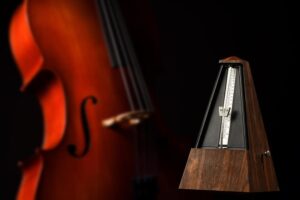 For all music students, whether in your first year of private cello lessons in Orlando or in your 15th year of playing, the metronome should always be there to help you. If you have never used a metronome before, be prepared to meet your new best friend, it will help you in your toughest times of fast musical runs and can even help sharpen up your scales – no pun intended! Even if you do not have your own metronome, there is no need to go out and buy the best or most expensive one out there, at least not yet. In this day and age, there are free metronome apps that you can download on your smart-phone or tablet, or even free metronome websites you can use if you are practicing near a computer. I find the best apps let you choose a tempo by number as well as by tapping your own beat. You can ask your in home cello teacher about this. I also like being able to add subdivisions (such as hearing the eighth notes or triplet beats), and be able to hear the downbeat at a higher pitch in most of the usual time signatures.
For all music students, whether in your first year of private cello lessons in Orlando or in your 15th year of playing, the metronome should always be there to help you. If you have never used a metronome before, be prepared to meet your new best friend, it will help you in your toughest times of fast musical runs and can even help sharpen up your scales – no pun intended! Even if you do not have your own metronome, there is no need to go out and buy the best or most expensive one out there, at least not yet. In this day and age, there are free metronome apps that you can download on your smart-phone or tablet, or even free metronome websites you can use if you are practicing near a computer. I find the best apps let you choose a tempo by number as well as by tapping your own beat. You can ask your in home cello teacher about this. I also like being able to add subdivisions (such as hearing the eighth notes or triplet beats), and be able to hear the downbeat at a higher pitch in most of the usual time signatures.
Getting Started
One of my favorite things to work on when I have my metronome on, are slow open-string warm-ups. In my private music lessons in Orlando I start with the A string, then lower the bowing arm each time to get to the next string over. With the metronome at 60 bpm (beats per minute), I play each string four times holding each bow for eight beats. This warm-up not only helps with bow management and control, but also tone production. After mastering the eight-beat bows, the next goal would be to hold the bow out for twelve beats!
Playing Scales
With almost every instrument, I believe scales are our musical vitamins. Both music lesson students and established players should work on them everyday and try to work them up gradually in tempo. I always start with a slow run-through first, with whole notes at 60 bpm (my favorite starting tempo). Then I use the Galamian method of accelerating through scales, which is what my teacher taught me, and what I still like to use with my own Orlando Cello Lessons students. Basically, you would keep the metronome going while you repeat the same scale (ascending then descending), but holding each note of the scale for less and less beats. It goes from whole notes to half notes, then quarter notes to triplet quarter notes (which means you would be fighting the duple beat, but a good skill to work on), then from eighth notes to sextuplets, and finally sixteenth notes. It may seem daunting at first, but try it with a comfortable tempo and then just work it up from there, every week or so pushing the metronome up a notch!
Working on Tricky Musical Sections
Now let’s say there are a few measures in the piece you have been working on that need attention. For example, four measures of just sixteenth notes ascending in pitch, with a goal tempo of 120 bpm for each quarter note. The best way to tackle this type of section would be to play it measure by measure with your metronome at half of your goal tempo – 60 bpm. Once each measure has been played at the 60 bpm at least separate three times, play it again at 70 bpm the same way, each measure repeated three times before moving onto the next measure of that section. Keep bumping up the tempo, just 10 clicks faster to 80, 90 and so on until you had reached your goal. You should not feel discouraged if you cannot reach your goal tempo in one practice session, as it may take a few days of practicing at a slower tempo until your fingers get used to moving faster and faster for that particular sequence of notes. If at first you don’t succeed, try, try, again!
And if you need some in-home cello lessons, Contact us!
About the Author:
Yamilet Trujillo has been playing cello for the past 15 years. She
is a Dr. Phillips High School alum, where she was accepted into
their Visual and Performing Arts Magnet Program. She
graduated from the University of Central Florida with a
Bachelors in Music Performance in 2010, studying with Barbara
George and Laurel Stanton, and also holds a Master
of Arts with a concentration in Music Education. Read More……

